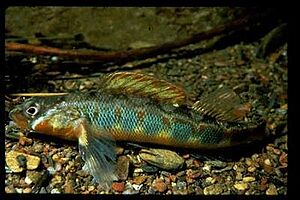Gilt darter facts for kids
Quick facts for kids Gilt darter |
|
|---|---|
 |
|
| Conservation status | |
| Scientific classification | |
| Synonyms | |
|
Alvordius evides Jordan & Copeland, 1877 |
The gilt darter (Percina evides) is a small, colorful freshwater fish. It belongs to the darter family, which is part of the larger perch family. You can find gilt darters in rivers that flow into the Mississippi River in the United States. Sadly, they have disappeared from some rivers because of dirt and pollution.
Male gilt darters are brighter than females. They can grow to about 9 centimeters (3.5 inches) long. This fish lives on the river bottom and mostly eats tiny water insects. During spring and summer, males claim their own areas for breeding. They usually lay eggs in shallow, fast-moving parts of the river called riffles. These areas have sandy and gravelly bottoms with bigger rocks. Some groups are working hard to protect gilt darters. They are even trying to bring them back to places where they used to live.
Contents
What Does the Gilt Darter Look Like?
Male gilt darters grow faster and get bigger than females. They can reach about 70 millimeters (2.7 inches) long by their third year. Some have been found to be as long as 94 millimeters (3.7 inches). Males are also much more colorful than females.
Where Do Gilt Darters Live?
The gilt darter lives in the upper parts of the Mississippi River Basin in North America. Historically, this fish was found in 18 states. However, it is now thought to be gone from New York, Iowa, Illinois, and Indiana.
You can still find them in western rivers that feed into the Mississippi River. This includes areas from the White River in northern Arkansas up to the St. Croix River in Minnesota and Wisconsin. In the east, they live in parts of the Tennessee River system in northern Alabama and the Ohio River system.
Gilt darters need clean streams. They are very sensitive to dirt and pollution. Because of this, they have disappeared from many streams in the Midwest. For example, the gilt darter has not been seen in Ohio since 1893. The last time it was seen in Indiana was in 1977. However, one small group of gilt darters still lives in the Tippecanoe River in Indiana.
What Do Gilt Darters Eat and Where Do They Live?
The gilt darter is a benthic fish, meaning it lives on the bottom of rivers. It mainly eats small water insect larvae. Studies show their diet mostly includes young mayflies, dipterans (like midges), and caddisflies. What they eat can change with the seasons and their age. Sometimes, they also eat black fly larvae and even snails.
Scientists have seen gilt darters follow other fish, like logperch. They try to steal food as the logperch search along the river bottom. Gilt darters have a varied diet. They can eat 7 to 10 different types of water invertebrates. They also eat larger prey and even fish eggs.
Gilt darters prefer cool, clear streams in higher areas. They like parts of the stream with faster water and more rocks on the bottom. Bigger gilt darters are often found where there are many different types of rocks and larger boulders.
How Do Gilt Darters Reproduce?
Gilt darters reproduce in the spring. Fish in warmer, southern areas start breeding earlier than those in northern areas. For example, in Arkansas, females ready to lay eggs were found in late April and early May. In Minnesota, breeding usually happens in June and July.
When they breed, the water temperature is typically between 16-23 degrees Celsius (61-73 degrees Fahrenheit). Males set up special areas for breeding. They usually lay eggs in the upper parts of fast-moving water called riffles. These spots have sandy and gravelly bottoms mixed with larger rocks. Females can lay between 130 and 400 eggs. The eggs hatch and the young fish grow past the larval stage within two weeks.
Protecting the Gilt Darter
The number of gilt darters has been slowly decreasing. This is mainly because of dirt and pollution in their habitats. The gilt darter used to live in 18 states. Now, it is believed to be gone from 4 of them. Only 3 states (Tennessee, North Carolina, and Arkansas) consider them a secure species. The other 11 states list the gilt darter as vulnerable, imperiled, or critically imperiled.
However, some fish biologists are working to help. They have found new ways to raise this fish. An organization called Conservation Fisheries, Incorporated (CFI) is leading these efforts. A recent project successfully brought gilt darters back to the Pigeon River in Tennessee. This project was a team effort between the University of Tennessee and CFI. Scientists hope to use what they learned from this success to help gilt darters in other states where they have disappeared but good habitats still exist.


